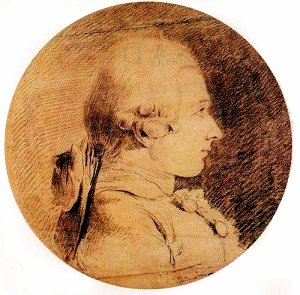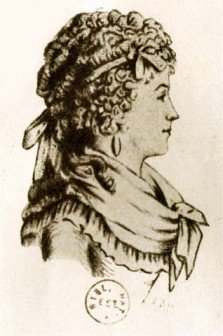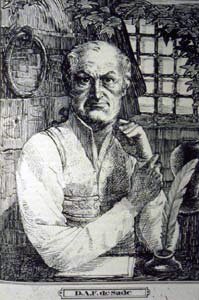Donatien Alphonse Francois, the Marquis de Sade

The notion of finding pleasure in another’s pain is, of course, far from a new development in the human psyche. Going back to ancient times, when the Assyrians boasted of mutilating their prisoners and murdering their children, there have always been those who found joy in tormenting others. It was not because of the novelty of his actions that the Marquis de Sade gave his name to sadism then, but rather for the novelty of his words. Many had felt this desire, and many had acted on it, but none had ever before thought to glorify it for its own sake as he did. His crimes were monstrous, but far from unusual for a French nobleman. It was his lack of shame that made him a monster.
Donatien Alphonse Francoise was born in a palace in Paris in 1740, the son of a diplomat and a princess’s lady-in-waiting. His parents had little hand in his upbringing, as his father was rarely home and his mother left him to the care of servants. At first he was raised at court, but at the age of six, he got into an argument with the young Prince Louis-Josephe and beat him severely, which resulted in him being banished from court. This was a great blow to his mother, who had sought to establish her son as a childhood friend of the prince and so assure his success in life. Donatien was sent to live with his uncle, the Abbé de Sade. Though his uncle was an abbot, he was far from a holy man and the young Donatien was witness to all kinds of debauchery. At the age of 10 he returned to Paris to attend a strict military school, where he was subjected to frequent corporal punishment for his wilful acts. At 14 he joined the army, with his noble birth entitling him to an officer’s commission despite his youth and lack of experience. Still, he had courage, and the sense to follow orders, though his conduct while on leave soon drew his father’s ire. He ran up large debts on both gambling and prostitutes, enraging the older man. In 1762, as Donatien’s military service came to an end, his father saw only one solution. He would have to get the boy married off.

His father’s concern was not only for his son, however. He was not a rich man, and had been ill able to afford the debt Donatien had landed him with. So it was that when his son began courting Anne-Prospère de Montreuil, the daughter of a rich merchant, his father quickly vetoed the match and instead arranged one with her elder sister, Renée-Pélagie, who was heir to the family fortune. Donatien was less than pleased (though the couple would still have three children together), and began an affair with Anne-Prospère soon after the marriage. This was the least of his infidelities, however. His new wealth allowed him to hire prostitutes, he had affairs with actresses, and in general he became one of the most notorious rakes in Paris, even being imprisoned for a brief period for blasphemy. It was Rosa Keller, a widow he hired as a housekeeper, who would push him from notoriety to infamy.
The exact details of the Rosa Keller affair, as it became known, are unclear, clouded in a haze of accusation, scandal and sensationalism that make it difficult to establish the facts. Rosa Keller was a thirty year old widow, reduced to begging on the street for alms. Donatien met her and seemed friendly enough, offering her a post as his housekeeper. The next day she turned up, only to find that the post he had in mind was rather different. One account, possibly the most reliable as it is the first known, has it that he showed her around the house, then took her to the attic and ordered her to strip. When she objected he drew a pistol and compelled her, then bound her hands and whipped her viciously. He held her prisoner or several days more, torturing her with a knife, until she managed to get free and jump from a window, drawing a passing policeman. De Sade was arrested, though the letter writer suspects he will escape punishment as “he comes from highly respectable people”. Quite. In fact, a letter by the same author the next day says that Donatien paid Rosa a large sum in damages, and she dropped the charges. The story grew in the telling, however, and some began to say that Donatien had intended to vivisect her, while others (more dangerously) spoke of blasphemy, with inverted crosses and the desecration of the host. De Sade himself claimed he had done it in order to test the efficacy of the salve he used on her wounds, though few credited the explanation. Though Donatien spent only six weeks in jail, the scandal destroyed any reputation he had and earned him the eternal enmity of his mother-in-law. Perhaps knowing that she had obtained a lettre de cachet [1] with his name on it, he prudently left the city.

Sexual licentiousness was hardly rare among the French nobility, of course, but Donatien was scandalous in both his choice of companions, and the activities he indulged in. He patronised low-class prostitutes, and he had his manservant Latour join in, with the two sodomising not only the prostitutes but each other as well. Sodomy was a capital crime in France at the time, and Donatien’s fascination with it would heavily influence his later writings. Unfortunately for him the good times came to an end in 1772 when some prostitutes decided to help themselves to his box of “candies” – which were heavily laced with cantharidin, an irritant that was often used as an aphrodisiac and which is more commonly known after the animal it is derived from, the Spanish Fly. Unfortunately cantharidin is also a deadly poison, causing severe illness in even mild overdoses. Stories vary as to whether the women survived, but the result was that Donatien and Latour fled, and were condemned to death in absentia.
De Sade fled to Italy, where he settled down with Anne-Prospère. For a short while he seemed to be trying to mend his ways, but then Anne-Prospère fell sick and died. She may have been the only woman he ever truly cared for. He tried to re-enter France, but was captured on the border and briefly imprisoned in Château de Miolans, the “Bastille of the Alps”. There he met a fellow spirit in recklessness, François-Marie de Lallée, the Baron de Songy, a nobleman who had been imprisoned a year earlier for cattle-rustling to pay his gambling debts. The two conspired together, and after four months of imprisonment Donatien and François managed to escape from the prison. [2] Donatien returned to Italy, where he briefly reconciled with his wife, though that did not last long. It was during this stay in Italy that he wrote his first book, a travelogue. In 1776 he returned to France and to his castle at Lacoste. Here he became notorious for his mistreatment of his servant girls, and the father of one even tried to shoot him, though the gun failed to fire. Outraged by his conduct, his wife and mother-in-law conspired to trick him into coming to Paris, where he was seized under the terms of the lettre de cachet and transported to prison.

Technically de Sade was still under sentence of death for sodomy and poisoning, but he was able to appeal that sentence and have it lifted. His imprisonment proved harder to deal with. While returning to the prison at Vincennes from an appeal he managed to escape, but was soon recaptured. His room in Vincennes was at first a true prison – a bed and no other furniture or luxuries provided. Even his food was delivered through a slot on the door, as his raging at his captors led them to treat him as a danger. After a year his wife (who hoped to rehabilitate him through imprisonment) managed to have him granted books and writing materials, though if she had known what he would write she might have had second thoughts. Deprived of the ability to sate his prodigious libido, the Marquis escaped into a word of fantasy that gradually grew more and more vicious, as shown by the work he created while imprisoned, 120 Days Of Sodom. In 1784 de Sade was transferred to the Bastille, where he continued to write. He took to shouting at passers by, and some credit his ranting with stoking the fires that led to the storming of the Bastille in 1789. If so, it was too late for him. He was transferred to the insane asylum at Charenton, ten days before the crowds broke into the prison and released the prisoners. His writings, which he had hidden in his cell walls, were left behind and lost. Donatien thought they were lost for good, and frequently mourned the loss of what he thought was his best work. In fact it would not be until 1904 that it was published.
It is perhaps fortunate for de Sade that it was lost, as it was by far the most vicious and perverted of the books he wrote – no mean feat. Even in the 20th century it was banned, and it still remains a controversial work. It tells the story of four rich men who retire to a castle for the winter, along with their four daughters, an assortment of male and female youths, some aged prostitutes and a group of accomplice torturers. There they indulge (over the course of the book) in pretty much every perversion imaginable, including torture and murder, until after four months (the 120 days of the title) the men emerge. The text is intended in part as a response to the Enlightenment ideal of the innate goodness of man, by showing the depravity and darkness it was possible for men’s souls to have. Only the first quarter of the book is actually complete, with the rest being mostly in outline, as de Sade clearly intended to complete it at a later date. Quite what reaction it would have provoked is hard to gauge, but it would not have ended well for de Sade.

In 1790 Donatien was released, as the new National Convention had declared the lettre de cachet system unconstitutional. His status as a former prisoner of the Bastille outweighed the stories of his escapades, which were by now very much old news. His estate in Lacoste had (like most noble estates) been destroyed by mobs, and so he decided to remain in Paris. Here he met and settled down with Marie-Constance Quesnet, a former actress (his wife having divorced him shortly after his release). His writing had given him an alternate outlet for his energies, and he wrote and published several utterly scandalous works anonymously over the next ten years, and though none was quite as brutally nihilistic and sadistic as 120 Days, they were still more than enough to cause a great deal of scandal in their own right. In his public life Donatien was smart enough to see which way the wind was blowing, and renounced his noble titles. He even entered politics and was elected to the National Convention, though his aristocratic background and his son’s desertion from the army both counted against him. In 1793, after he was overly critical of Robespierre, he was arrested for “moderatism” and imprisoned, though he was released after a year when Robespierre fatally fell from grace with the mob.
Donatien continued to write, being forced to sell Lacoste to make ends meet, until 1801. That year Napoleon Bonaparte ordered that the author of a pair of erotic novels, Justine and Juliette, be tracked down and arrested. The novels tell the story of the two eponymous sisters, both raised in a convent. Justine does her best to live a virtuous life, and so is subjected to rape, torture and misfortune throughout her life, eventually winding up sentenced to death for a crime she did not commit. Juliette, on the other hand, lives a life soaked in vice, committing vicious murders simply for the joy of doing so, and so winds up a rich noblewoman, familiar with (in more than one sense) the ruling elite of Europe. She even seduces the Pope, after recounting the many (and historically accurate) sexual exploits of his predecessors. The pair of novels express de Sade’s vicious philosophy – that nature has implanted urges within humanity, and so to act upon those urges (no matter how murderous or perverted they may be) is the truly virtuous act, while to suppress them is the true sin. Horrified by this worldview, Napoleon declared Justine “the most abominable book ever engendered by the most depraved imagination”. [3]
Donatien was tracked down and arrested, once again without trial. At first he was held in prison, but his family’s intervention saw him declared insane in 1803, and he was transferred to the asylum at Charenton. Here his imprisonment was much less severe, and Marie-Constance was even allowed to live with him. Though his level of freedom rose and fell with the changes in the asylum management and the relative notoriety of his works, he remained in relative comfort until he died in 1814.

After de Sade’s death his son had his remaining unpublished manuscripts destroyed, and for the rest of the 19th century he remained an obscure figure. The rediscovery of 120 Days of Sodom, right as the craze of Freudianism was gripping Europe, catapulted him into the limelight. In 1905 Sigmund Freud took his name and coined the word “Sadism”, the psychological condition of deriving pleasure from another’s pain. De Sade was thus established in the popular perception as the ultimate sadist, the original and the greatest. Of course, this was far from true, but nor was he simply “the freest spirit that had ever lived”, as the French poet Guillaume Apollinaire described him. His reputation continued to grow down these two paths, with the Surrealists championing him as a kindred spirit, while popular fiction reduced him to a two-dimensional villain. Even to this day, the dichotomy continues. In Grant Morrison’s The Invisibles, the time-travelling anarchists recruit de Sade to act as a creative consultant for their plans to reshape humanity’s psyche, while the film Quills shows him as a tortured genius victimised by a system far more sadistic than he ever was. On the other hand, de Sade is often simply used as a historical monster, with films such as Waxwork placing him alongside historical serial killers and cinematic monsters.
The truth, of course, is far more complex than any fictionalised version. De Sade was a cruel man, one who lacked empathy and viewed the experience of others as less important than his own. His philosophical views are simply sociopathy distilled into florid language. His characters are not simple libertines, but are often closer to serial killers, and de Sade applauds them for their evil. Yet he was at least an honest man, willing to admit to his own sins and his own nature. One can admire him for that lack of hypocrisy, but there’s no getting away from the fact that he was, through and through, a pretty terrible person.
Images via wikimedia and metroactive.
[1] An order for indefinite imprisonment, signed by the King. Pre-Revolutionary France paid little heed to notions of due process and the rule of law.
[2] The Baron de Songy was recaptured in Paris shortly thereafter, though he attempted suicide to avoid returning to prison. After ten years he was released due to an appeal to the king by his wife, and he showed his gratitude by taking up with a mistress and having three children by her.
[3] He clearly hadn’t read Juliette, which is frankly even worse.

